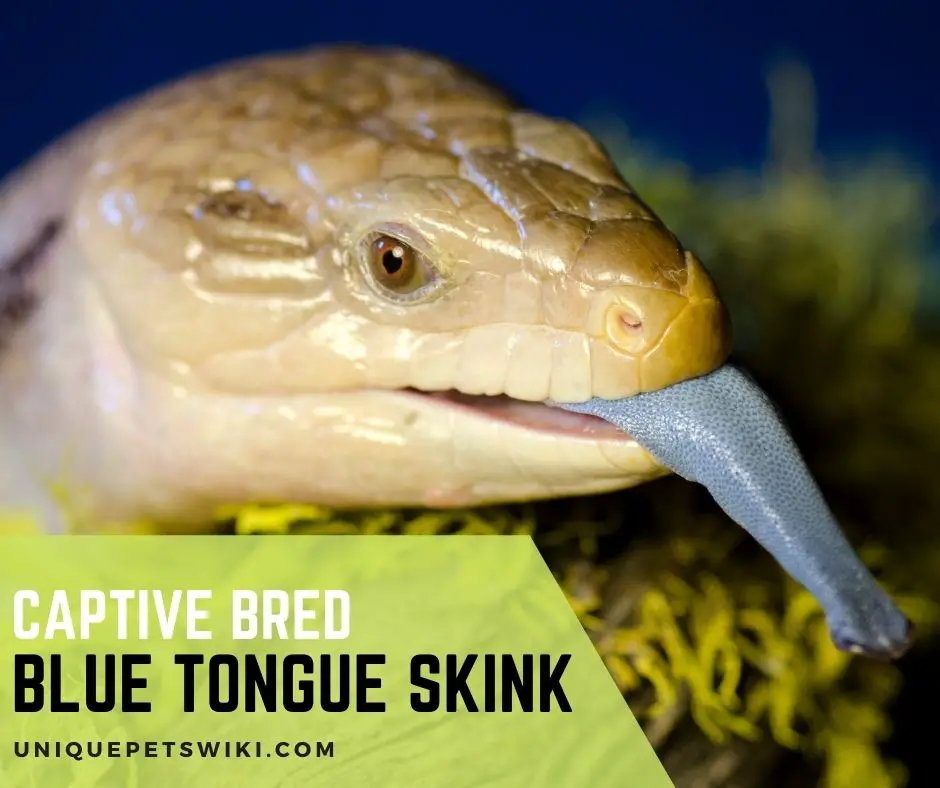Blue tongue skinks are fairly large lizard species from Australia, Tasmania, New Guinea, and Indonesia.
Although blue tongue skinks are unique reptiles, they make a great pet, and their popularity is increasing over the years.
Blue tongue skinks are among the most popular pet skink that can be bred in captivity. Breeding them in captivity also makes them friendly and makes raising them easier.
Since blue tongue skinks are not as popular as other lizard pets, you may be wondering whether you should opt for captive-bred or wild caught blue tongue skinks.
In this article, we will highlight everything you need to know about captive bred blue tongue skinks, from how to breed them to the cost of a captive-bred BTS.
Contents
Captive Bred Blue Tongue Skink?
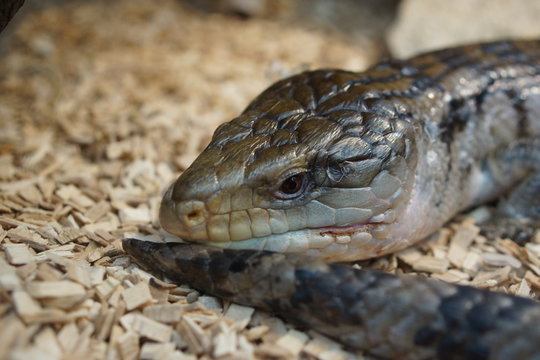
Captive-bred blue tongue skinks are popularly found in the US. Captive-bred blue tongue skinks are usually bred in captivity by parent skinks that are long-term captives or even captive-bred.
This means they are more suited for keeping as a pet and are quite healthy.
Captive-bred blue tongue skinks are friendly and hardy pets and usually love handling sessions with their caregivers.
How To Breed Blue Tongue Skink In Captivity?
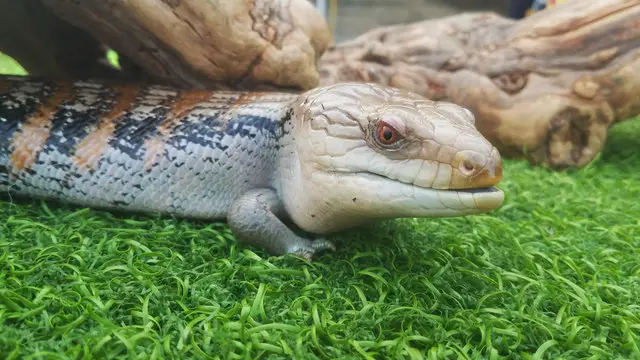
Breeding blue tongue skink is not something to be taken lightly as lots of things happen during this process.
Furthermore, you should not be in a rush when breeding a blue tongue skink in captivity.
The breeding season of blue tongue skinks usually starts from September all through to November.
You can determine if your blue tongue skink is ready for breeding if it has reach sexual maturity (18 months to 2 years).
However, you can plan to breed your blue tongue skink in captivity by following their natural cycle. Here are steps to follow if you want to breed your blue tongue skinks in captivity.
- The first thing is to dedicate your time to learning about breeding blue tongue skink from an experienced breeder. This will help make your lizard’s breeding a successful and less stressful experience for you and your pets.
- Determine your blue tongue skinks genetic and lineages before you start breeding. Doing a genetic analysis on the parents is essential if you want to produce a healthy hatchling.
- Take your blue tongue skinks to a vet to help determine whether your breeding stock is healthy and fit to breed.
- Prepare your skinks for brumation if you are breeding them in captivity. However, it is best to follow your blue tongue skink natural cycle and allow them to brumate during the winter period.
- Female blue tongue skinks need to be in good health during the breeding period. This is why it is recommended to feed female broodstock with a diet rich in calcium and vitamin supplements.
- Prepare a separate breeding tank for your breeding stocks. This is because blue tongue skinks are territorial animals and will aggressively fight for space. Creating a separate breeding tank will help reduce their aggression towards each other.
- Introduce the male to the female broodstock for breeding. Once you notice that the male is not showing interest in the female, you should just remove it and introduce another male ready to mate. Furthermore, when the female is very aggressive or does not open her cloaca for penetration, you should take the male out and wait until it is ready.
- Once the breeding process is successful, wait and observe that the female has conceived by checking her weight regularly.
- Take good care of pregnant blue tongue skinks by increasing their feeding times to at least every two days and adding lots of calcium and vitamin supplements in their diet. You can also provide physical exercise for your skink to keep her in good shape.
- Prepare a different tank for your blue tongue skink babies.
Note: Breeding of blue tongue skinks is quite aggressive, and it is best that you supervise them during this period.
Also read: Baby And Juvenile Blue Tongue Skinks Care Guidelines
Distinguish Between Captive Bred and Captive Born and Bred (CBB) Skink and Wild Caught (WC)
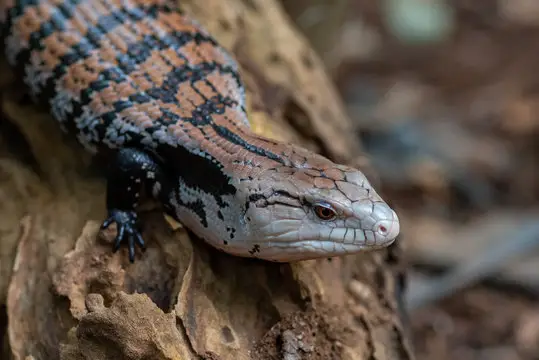
A captive-bred skink is obtained when an importer receives a wild-caught female skink that is gravid.
The importer then keeps the female skink to obtain the babies and then sells them afterward.
There are scenarios where captive-bred skinks are also wild-caught skinks kept in outdoor enclosures in their native environment where they reproduce on their own.
A captive born and bred skinks are usually produced in captivity by parent skinks that may be captive-bred skinks themselves or are long-term captives.
Unlike captive bred skinks, the breeder will facilitate the breeding of the parent breed stock in a captive setting.
On the other hand, wild-caught blue tongue skinks are obtained from the wild. They are also called the field-collected skink.
It is quite hard to tame wild-caught blue tongue skinks and usually needs medical treatment to help them survive for a long time.
Pros and Cons of Captive Bred Blue Tongue Skink
Here are some pros and cons of buying captive-bred blue tongue skinks.
Pros
- It is easy to tame them
- They are available at an excellent price
- You can buy them at your local pet shops, reptile dealers, and reptile expos.
Cons
- They are susceptible to illness and parasites
Where Is The Best Place To Buy A Captive Bred Blue Tongue Skink?
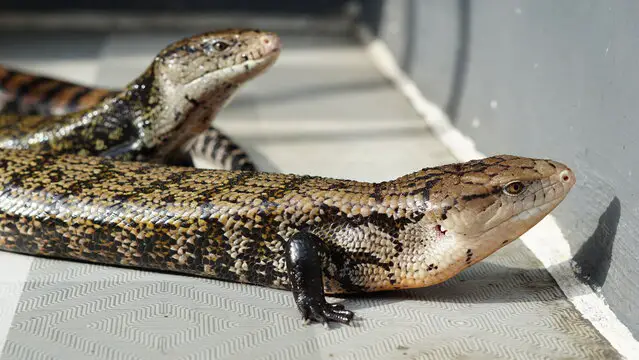
Some of the places where you can buy captive-bred blue tongue skinks are from a local pet shop, reptile dealers, and from reptile expos.
You will get to buy a captive-bred blue tongue skink at a reasonable price from these sources.
However, the skinks are susceptible to parasites and illnesses. Furthermore, the importation process to get captive bred skinks to the stores is quite stressful to the skinks.
Reptile dealers and local pet shops can also keep the skinks in overcrowded conditions, leading to injuries as the skink fights for space.
Tips To Follow When Buying A Captive Bred Blue Tongue Skink
- Always do a health check on the blue tongue skink before buying it. You can also check their tank and ask questions before you buy it.
- Try to handle or ask the employees to handle the skink and then observe it. It is recommended to buy a calm and curious skink and avoid choosing a skink that hisses or tries to escape during handling sessions.
- When buying from reptile expos and dealers, try to research the seller beforehand to help determine if they are honest and reputable.
How Much Is A Captive Bred Blue Tongue Skink?
A captive-bred blue tongue skink will cost between $150-$300. However, special color morphs and varieties can cost over $1000.
Also read: Buy Blue Tongue Skink – Cost And 5 Tips To Choose A Good Healthy Skink
BIOTERIUM Reptile Tank | 36 x 18 x 18 Inch Glass Tank for Reptiles
- PROVIDE YOUR PET WITH A SPACIOUS, COMFY HOME - Keep your snake, lizard, or gecko comfortable and where you can see them with our 190 L (50 Gal) glass terrarium for reptiles - featuring a full front glass opening and accompanied with a realistic terrarium background.
- RAISED BOTTOM FRAME AND WATERPROOF GLASS BOTTOM FOR VERSATILE USE - A raised bottom frame leaves space for a substrate heater makes this perfect for a desert lizard terrarium. With a waterproof bottom, it's also easy to create a tropical terrarium perfectly suited to a gecko, python, or frog.
- EASILY ACCESSIBLE FOR FEEDING, CLEANING, AND DECORATING - The front doors open separately, making this reptile terrarium easily accessible for feeding and convenient cleaning, decoration, and maintenance. A specially designed lock also helps prevent escape.
- VENTILATED HABITAT WITH CONVENIENT WIRE OUTLETS - Our terrarium tank includes a removable mesh top so your pet can enjoy optimal airflow, UVB and infrared penetration, and dome lighting. Wire outlets on the side and top doors are there for your convenience.
- EASY 5- MINUTE INSTALLATION - We've included everything you need for a hassle-free, straightforward installation. With our clear instructions manual, assembly should take you only about 5 minutes!
Last update on 2022-12-30 / Affiliate links / Images from Amazon Product Advertising API
What Species of Blue Tongue Skinks are Often Captive Bred?
Many reptile dealers usually pass off captive-bred Indonesian skinks as captive-born and bred northern skinks either intentionally or unintentionally.
You can avoid falling victim to this by researching and knowing how to distinguish northern skink from other species.
It is common to get northern skink babies during the summer months. You can also research the vendors selling blue tongue skinks to help determine trustworthy ones.
Zilla Reptile Munchies Omnivore with Calcium 4 Ounces
- Nutritious, Dehydrated Ingredients That Are Quick And Convenient - No Refrigeration Required! With Calcium
- Calcium Is Essential To Reptiles For The Prevention Of Metabolic Bone Disease
- Easy To Prepare - Just Rehydrate In Water
- Provides Nutritious Variety From Natural Ingredients In A Convenient, Resealable Package
- Ideal For Reptiles Such As Bearded Dragons, Water Dragons, Tegus And Box Turtles
Last update on 2022-12-29 / Affiliate links / Images from Amazon Product Advertising API
Wrapping Up
It is better to buy a captive-bred blue tongue skink than opting for wild-caught ones. Captive-bred blue tongue skinks are usually hardy and will make a better pet.
Furthermore, they will become friendly to their owners, which makes handling them very easy.
